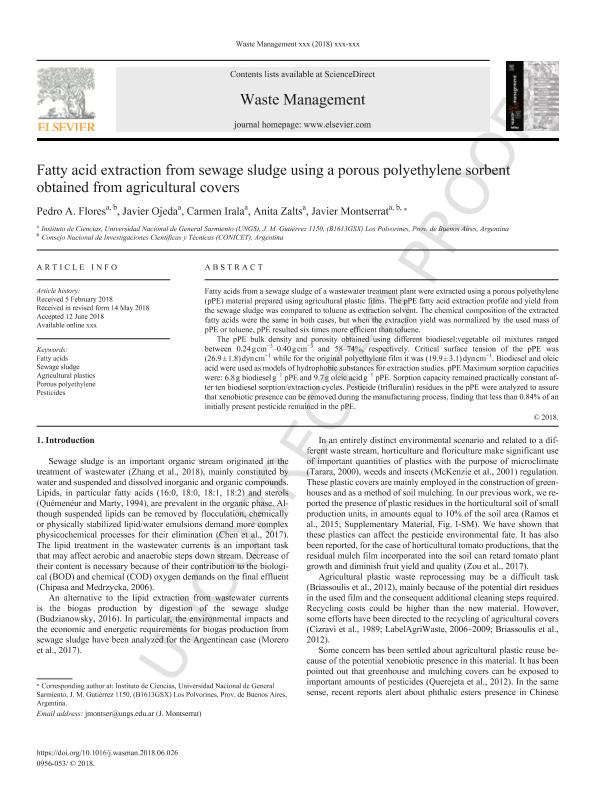Mostrar el registro sencillo del ítem
dc.contributor.author
Flores, Pedro Agustín

dc.contributor.author
Ojeda, Javier
dc.contributor.author
Irala, Carmen
dc.contributor.author
Zalts, Anita

dc.contributor.author
Montserrat, Javier Marcelo

dc.date.available
2020-03-16T19:50:48Z
dc.date.issued
2018-08
dc.identifier.citation
Flores, Pedro Agustín; Ojeda, Javier; Irala, Carmen; Zalts, Anita; Montserrat, Javier Marcelo; Fatty acid extraction from sewage sludge using a porous polyethylene sorbent obtained from agricultural covers; Pergamon-Elsevier Science Ltd; Waste Management (elmsford); 78; 8-2018; 532-540
dc.identifier.issn
0956-053X
dc.identifier.uri
http://hdl.handle.net/11336/99679
dc.description.abstract
Fatty acids from a sewage sludge of a wastewater treatment plant were extracted using a porous polyethylene (pPE) material prepared using agricultural plastic films. The pPE fatty acid extraction profile and yield from the sewage sludge was compared to toluene as extraction solvent. The chemical composition of the extracted fatty acids were the same in both cases, but when the extraction yield was normalized by the used mass of pPE or toluene, pPE resulted six times more efficient than toluene. The pPE bulk density and porosity obtained using different biodiesel:vegetable oil mixtures ranged between 0.24 g cm−3–0.40 g cm−3 and 58–74%, respectively. Critical surface tension of the pPE was (26.9 ± 1.8) dyn cm−1 while for the original polyethylene film it was (19.9 ± 3.1) dyn cm−1. Biodiesel and oleic acid were used as models of hydrophobic substances for extraction studies. pPE Maximum sorption capacities were: 6.8 g biodiesel g−1 pPE and 9.7 g oleic acid g−1 pPE. Sorption capacity remained practically constant after ten biodiesel sorption/extraction cycles. Pesticide (trifluralin) residues in the pPE were analyzed to assure that xenobiotic presence can be removed during the manufacturing process, finding that less than 0.84% of an initially present pesticide remained in the pPE.
dc.format
application/pdf
dc.language.iso
eng
dc.publisher
Pergamon-Elsevier Science Ltd

dc.rights
info:eu-repo/semantics/openAccess
dc.rights.uri
https://creativecommons.org/licenses/by-nc-sa/2.5/ar/
dc.subject
AGRICULTURAL PLASTICS
dc.subject
FATTY ACIDS
dc.subject
PESTICIDES
dc.subject
POROUS POLYETHYLENE
dc.subject
SEWAGE SLUDGE
dc.subject.classification
Físico-Química, Ciencia de los Polímeros, Electroquímica

dc.subject.classification
Ciencias Químicas

dc.subject.classification
CIENCIAS NATURALES Y EXACTAS

dc.title
Fatty acid extraction from sewage sludge using a porous polyethylene sorbent obtained from agricultural covers
dc.type
info:eu-repo/semantics/article
dc.type
info:ar-repo/semantics/artículo
dc.type
info:eu-repo/semantics/publishedVersion
dc.date.updated
2020-03-11T13:01:05Z
dc.journal.volume
78
dc.journal.pagination
532-540
dc.journal.pais
Países Bajos

dc.journal.ciudad
Amsterdam
dc.description.fil
Fil: Flores, Pedro Agustín. Consejo Nacional de Investigaciones Científicas y Técnicas; Argentina. Universidad Nacional de General Sarmiento. Instituto de Ciencias; Argentina
dc.description.fil
Fil: Ojeda, Javier. Universidad Nacional de General Sarmiento. Instituto de Ciencias; Argentina
dc.description.fil
Fil: Irala, Carmen. Universidad Nacional de General Sarmiento. Instituto de Ciencias; Argentina
dc.description.fil
Fil: Zalts, Anita. Universidad Nacional de General Sarmiento. Instituto de Ciencias; Argentina
dc.description.fil
Fil: Montserrat, Javier Marcelo. Universidad Nacional de General Sarmiento. Instituto de Ciencias; Argentina. Consejo Nacional de Investigaciones Científicas y Técnicas; Argentina
dc.journal.title
Waste Management (elmsford)

dc.relation.alternativeid
info:eu-repo/semantics/altIdentifier/url/https://www.sciencedirect.com/science/article/pii/S0956053X18303805
dc.relation.alternativeid
info:eu-repo/semantics/altIdentifier/doi/http://dx.doi.org/10.1016/j.wasman.2018.06.026
Archivos asociados
